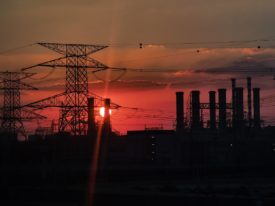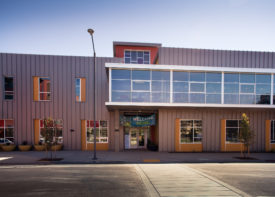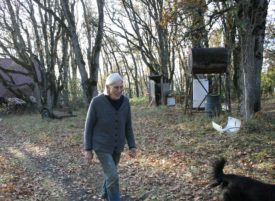 Saul Alinksy—the fabled organizer (pictured) whose approach to grassroots mobilization has informed generations of activists, including the young Barack Obama—never promoted energy efficiency, to my knowledge.
Saul Alinksy—the fabled organizer (pictured) whose approach to grassroots mobilization has informed generations of activists, including the young Barack Obama—never promoted energy efficiency, to my knowledge.
But his institutional descendants are doing so now. The Chicago-born Industrial Areas Foundation, which Alinsky founded, has a Northwest branch, and that branch—long an inspiration to me for its creative thinking and deep community engagement—has crafted an intriguing plan for boosting both good jobs and green energy at the same time. Called SustainableWorks, it’s the kind of thing that can speed both economic turnaround and recovery from oil addiction and climate change.
SustainableWorks is a plan for structuring the marketplace for clean-energy retrofits.
What? Structuring the marketplace?
More simply put, it would create a few missing institutional links and thereby allow a whole bunch of organizations with shared interests to find each other and cooperate: neighborhood groups, building owners, skilled energy auditors, reliable contractors, workforce training programs at community colleges, union apprenticeships in green construction, utilities and other public and private conservation funders.
The results would include neighborhood-wide energy upgrades that are more thorough and less expensive than what we get now, plus more—and better—new jobs with better training and better career prospects over time.
The plan starts from the recognition that, for all that’s important about energy efficiency, it’s a real hassle to save energy in existing buildings, especially small buildings like houses, duplexes, low-rise apartments, and neighborhood commercial buildings.
Typical building owners don’t know much about the energy performance of their structures, so, in general, they pass over ample opportunities for efficiency.
These oversights are understandable. For one thing, the financial stakes of energy use are not that big, compared to other costs of ownership. For another, boosting building energy efficiency is not a self-evident process. Most owners don’t know where to add insulation; what appliances to replace early and what to replace them with; the relative cost-effectiveness of solar water heaters, ground-based heat pumps, triple-paned replacement windows, and on-demand water heaters; what a waste-heat recovery system is; which lighting systems to replace; or how to use a blower door. (Come to think of it, I don’t know those things either, and I’ve already admitted to an aberrational enthusiasm for home energy savings.)
Even if a building owner is personally interested in such things, she is likely unsure whom to trust. Shopping for energy-using devices isn’t a weekly chore, like picking up groceries. It’s rare, the vendors tend to be specialized, and many of the devices must be installed by specialized tradespeople. Not all such tradespeople are reputable and reliable. Most small building owners are not general contractors, engineers or architects. How are they supposed to make informed decisions about such things?
At the same time, electric and natural gas utilities and public agencies have money to spend encouraging efficiency. Construction workers are getting pink slips by the hundreds as the economy melts down. Unemployment rates are up, especially among low-skill and semi-skill workers from low-income families. And public concern around fossil-fuel dependence, oil addiction, and climate change are at historic highs.
SustainableWorks is a program designed to re-arrange (or “organize”) all these problems into one solution. Like TravelSmart’s intensive focus on one neighborhood at a time, SustainableWorks will send outreach workers door to door engaging small building owners and signing them up for comprehensive energy audits performed by certified auditors. Next, SustainableWorks will provide referrals to top-notch contractors who the building owner can count on to do the job well, and who have verified to SustainableWorks that they’re training and hiring low-income workers into union-wage green-collar jobs. SustainableWorks will also facilitate the financing of the project; it will assemble a pool of capital that it can deploy to different projects. Low-income renters may get free retrofits paid for with public dollars, while middle-class homeowners get easier access to existing market-rate loan programs from local banks. SustainableWorks will help oversee and do quality-control on contractors’ work; it will also evaluate and certify contractors’ work, to make sure the retrofits are completed properly.
(See what I mean now by “structuring the marketplace for clean-energy retrofits”?)
In Spokane, where SustainableWorks had its start, it has completed six retrofits in six buildings. The program’s next step is to launch four $1-million pilot projects of its neighborhood-wide model near Portland and Tacoma, and in Seattle and Spokane. This month, its sponsors from the Industrial Areas Foundation hope to secure start-up funding from utilities and public agencies.
I rarely get excited about organizational charts, but SustainableWorks is an exception. By completing the missing circuit in energy efficiency upgrades for small buildings, it could unleash substantial results for the climate, our communities, and working families. And four $1 million pilots isn’t much, considering the talk in Washington, DC, of an economic stimulus package that might total $300 billion.
Maybe we should do a SustainableWorks pilot project in every Cascadian city and town? A quick check reveals 242 incorporated cities in the state of Oregon. So maybe $1 billion federal dollars would suffice to cover Cascadia?









ROBERT CREMEANS
I am the executive director of the Ivyland Foundation for historic and architectural preservation. At this point in history I believe that I have the most amazing opportunity in the U.S.A. to supply an organizing model for neighborhood-wide energy upgrades. I am purchasing a turn of the century agricultural facility( a feed pellet processing mill from the 1890s)50,000 sq.ft. under 4 roofs occupying 4 corners at the intersection of 3 roads and junction of a scenic railroad with steam locomotive in the 3rd smallest municipality in the commonwealth of Pennsylvania. contact me 267-253-6108, this is a victorian village circa 1873 with a mill that could be outfitted ti process fuel pellets. the business occupying the mill is a hearth shop that sells, services and installs pellet stoves, inserts, furnaces and boilers
Sean Penrith
It is wonderful to hear of the organized effort SustainableWorks is making. I see the need for tracking accountability to ensure that quality retrofit work is being done so that energy efficiency improvement indeed occurs. The increased appraised value of an upgraded home also needs to be factored. This is a neat fit for the EPS. The Energy Performance Score (EPS) is a miles-per-gallon (MPG) type rating system for energy use in new and existing homes. The EPS measures a home’s energy consumption and carbon emissions and expresses these as energy and carbon scores with comparisons to regional averages and efficiency goals. The accompanying report includes a performance analysis of the various energy related elements of the home and recommendations for cost effective improvements. Homeowners will be able to compare their EPS scores to those of other homes, take measures to improve the scores, and use enhanced energy performance as a valuable selling point.In addition, an EPS will provide municipal governments, utilities, and the real estate industry with information about the energy use and carbon emissions of homes in a region, thus offering benchmarks for comparisons and for measuring progress toward critical energy and climate goals. The pilot phase of the EPS, supported by Energy Trust of Oregon, is being conducted on 300 existing homes by the nonprofit organization Earth Advantage, Inc. in collaboration with Conservation Services Group. Earth Advantage, Inc. will issue a report upon completion of the pilot at the end of 2008 detailing the recommended protocol, audit procedures, software modeling tools, price points, and consumer messaging for wide scale delivery of the EPS and areas for further study.This comprehensive initiative is attracting national interest. The City of Seattle, City of Chicago, City of Houston, Clinton Climate Initiative, US Department of Energy, New York State Energy Research and Development Authority, and the World Business Council for Sustainable Development are just some of those indicating interest in the pilot’s findings.The EPS concept has been adopted for consideration by the governor of Oregon for the 2009 legislative session including the proposal that EPSs be administered on a voluntary basis for two years. Thereafter, an oversight body will recommend if and when new and existing homes should be required to carry an EPS along with the incentive structures needed to improve home energy performance and align with the carbon reduction goals such as those for the state, the Western Climate Initiative, or the American Institute of Architects’ 2030 Challenge.For more information about the EPS, please contact Sean Penrith, Executive Director of Earth Advantage Inc., at spenrith@earthadvantage.org.